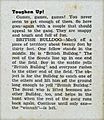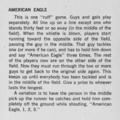British Bulldog (game) facts for kids
British Bulldog (also known by many other names like running red rovers or octopus) is a fun tag-based game. It's a bit like Red Rover, but with its own exciting twists!
Usually, one or two players are chosen to be the "bulldogs." They stand in the middle of the playing area. Everyone else, the "runners," starts at one end of the area, which is called "home." The main goal of the game is for the runners to dash from one end of the field to the other without being caught by the bulldogs. If a runner gets caught, they become a bulldog too! The game keeps going until only one or a few players are left "free." They are the winners!
You can play British Bulldog almost anywhere with enough space, like a playground, a large hall, or a field. There's no set size for the playing area or a perfect number of players, as long as everyone has room to run and have fun.
This game is super popular with kids in many countries, especially in the United Kingdom, Republic of Ireland, South Africa, Australia, New Zealand, and Canada. It's also played in the United States where it's often called "sharks and minnows." British Bulldog started in the UK and has been around for a long time, with different versions recorded since the 1800s.
Because British Bulldog can be very physical, it was sometimes banned from schools in the past due to injuries. However, things are changing! Many schools now allow it, especially if players agree to a "non-contact" version. This means instead of tackling, bulldogs just tag runners, like in a regular game of tag.
Contents
How to Play
Like many games, the exact rules of British Bulldog can change a bit depending on where you play, but the main idea stays the same.
The playing area has a main part in the middle and two "home" areas at opposite ends. Think of them like the end zones in rugby or American football. These home areas are usually marked by a line.
A game of British Bulldog has several rounds. You usually play many games in a row, with different players becoming bulldogs each time.
To start a game, one or two players become the "bulldog(s)" in the middle. All the other players gather in one of the home areas. The goal for the runners is to sprint from one home area to the other without being caught by the bulldog(s) in the middle.
Later in the game, there will be more bulldogs than runners. This can make it really exciting as many bulldogs try to catch the last few runners!
Rounds
Each round often begins with the bulldog(s) calling out to the runners, sometimes even daring a specific player to run first. In some versions, all the runners dash across at once. In others, the run starts when the bulldog(s) or a named player gives a signal. Once players leave the home area, the bulldog(s) can try to "catch" them. Any player who gets caught becomes a bulldog too!
The round then repeats, with players running in the opposite direction, until all players have become bulldogs.
Getting Caught
How a runner gets caught can vary. A common way is for the bulldog(s) to hold the runner still, or even lift them off the ground, while shouting a phrase like "British bulldog; one, two, three!" or just "British bulldog!" If the runner can escape before the phrase is finished, or if they can keep moving (if being held still is required), then they are not caught. This version is sometimes called "take down bulldog."
A simpler and safer way is for the bulldog(s) to just touch the runner's head or back and say the phrase. This is more like a regular tag game.
In some versions, runners also become bulldogs if they step out of bounds, like crossing a side line. A bulldog can even try to push a runner out of bounds to catch them.
If runners make it safely into the opposite home area without being caught, they are "safe" and can't be caught by the bulldogs. Players are also safe while they are in their starting home area, though sometimes there are rules about how long they can stay there.
The Rush
The "rush" (also known as the 'bullrush' or 'stampede') is when the runners make their dash. It can be started by the bulldog or a specific player shouting a phrase like "bulldog" or "bullrush." Or it might happen when the named player is caught or safely reaches the other side.
In most versions, runners can choose when to try to cross. The round only ends when all runners are either safe on the other side or have been caught. Bulldogs can usually catch many players in one rush, and all of them become bulldogs. However, in some versions, only the first player caught in each round becomes a bulldog.
In some games, once a player leaves the home area, they can't go back to it.
Winning
For the bulldogs, the goal is to catch all the runners as fast as possible. For the runners, the goal is to stay uncaught for as long as they can. The very last player to be caught is usually the winner!
Other Ways to Play (Variants)
Many different names and rules exist for games similar to British Bulldog. Here are a few:
Bacca
A version called bacca was played in the 1800s. To catch someone, the bulldog had to hold them and say "One, two, three, caught, tobacco." The word "tobacco" gave the game its name!
Black Tom
In the black tom game from early 1900s America, the catcher starts the rush by shouting "Black Tom" three times. The catcher might try to trick players by shouting something similar, like "Black Tim." If any player runs on a trick signal, they are automatically caught!
Chinese Wall
Chinese wall is a variant where the catcher stays in a smaller area called the "wall" in the middle of the field. Runners must cross this "wall" without being caught.
Click
In a game called click, played in Marlborough, England, being the catcher was called "going Click." Catchers held players and said, "One, two, three, I catch thee; help me catch another." If the last runner made it across three times without being caught, they got to choose who went "Click" next. If they failed, they had to be the catcher themselves.
Cock
A game from the late 1800s called cock had the catcher known as the "cock." All runners would run at once, and the cock would catch them by putting their hand on the runner's head.
Downhill Bullrush
This version was played in Wellington, New Zealand in the 1970s. Runners started at the top of a steep hill, and catchers waited halfway down. It was a tackle/restraint game.
Fishy Fishy
Fishy fishy is a gentler version popular in Britain. Runners ask, "Fishy, Fishy, may we cross your golden water?" The catchers respond with a rule, like "Only if you're wearing blue!" This makes runners cross in smaller groups, and catchers usually just tag them.
A similar game in America is sharks and minnows. The original players are "sharks" who try to "eat" the "minnows" (runners). If a shark tags a minnow, the minnow becomes "seaweed" and can't move, but can still tag other minnows.
There's also a "sharks and minnows" played in swimming pools! The "shark" starts on one side, and "minnows" swim across without being tagged by the shark while above the water. Tagged minnows become sharks for the next round.
Ghost in the Graveyard
This game, from places like Iowa and Minnesota, is unique because it has one "home base" and players run in a circle around an object like a house. Players count "One o’clock, two o’clock..." while the "ghost" hides. At "midnight," they chant "Starlight, moonlight, I hope to see a ghost tonight," and look for the hider. When the ghost jumps out, everyone runs back to base!
Hopping Jinny
In hopping jinny, players must hop all the time with their arms folded. The catcher catches players by bumping into them and making them put their other foot down.
Another hopping game is hopping bases. There's a "castle" in the middle, and the catcher is the "king." Anyone caught by the king becomes a "soldier." Players must hop between home areas. If the king puts both feet down, they have to go back to the castle before catching more players.
There's even a team version where captured players become "prisoners" in the other team's home area. Teammates can rescue them by hopping over and touching them!
King Caesar
In King Caesar, from the early 1900s, the catcher(s) are the "king." They catch players by tapping them on the head and saying "I crown thee King." Once a player leaves a home area, they can't go back. When the kings outnumber the runners, they can even try to pull players out of the home area to catch them!
Octopus
The octopus variant is played in places like Belfast and Vancouver. The catcher(s) are called "seaweed." When a player is caught, they are "rooted" to that spot, like in freeze tag. They can then try to tag other runners without moving.
Pom-pom-pullaway
A milder version of British Bulldog, pom-pom-pullaway, was popular in the American West and Midwest. The catcher (sometimes called the "stump") is in the middle. The rush starts when the catcher shouts a phrase like "pom-pom-pull-away; come away or I'll fetch you away." Players are usually caught by being tagged. The first player caught becomes the catcher in the next game.
A variant called hill dill uses the phrase "Hill Dill, come over the hill; or else I'll catch you standing still."
Spider and Fly
This game is just like British Bulldog, but players yell "Mr. Spider, Mr. Spider, may we cross your web?" before they run across.
Why We Play It
British Bulldog is a game that lets kids burn off lots of energy and involves a lot of active, physical play. It's great for competitive spirits, but it also encourages teamwork as all the "caught" players work together to catch the "free" ones. Even the strongest players will find it tough to win when there are many bulldogs!
Sometimes, playing British Bulldog can lead to a few bumps or scrapes, especially if played on hard surfaces. But both boys and girls love to play it! It's a bit like rugby because it involves trying to hold or tackle others.
Images for kids


















